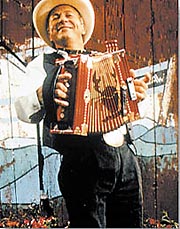
I immediately was made a jug hustler. A jug hustler carries an 80-pound bag of geophones (jugs) used for seismographing in search for oil. I was one of 10 company employees working with some 70 Cajuns.
The living quarters on the two large, movable barges floating in the swamps consisted of two large army barracks mounted on top. The upper floors served as sleeping quarters with personal areas, while the lower floors served as dining area and kitchens with rest rooms containing showers at the end. A third barge was filled with potable water and used for docking the crew boats.
Since I was underage, my folks had to pull a lot of strings and sign a release for me to work for Phillips Petroleum. Since I was the youngest person there, I was teased a lot by the Cajuns.
Usually, the name “Cajun” is used to describe the French people from south Louisiana. The Cajuns I met and worked with were local people that were always having fun and never seemed to grow up. They called one another “Hoss” or “Budro”.

There was a boat siren on the top front of the boats that could be heard for miles. Once in a while, one of the Cajuns in the boat would switch on the siren. It would present an ear-splitting noise to those sitting near the siren. Once on our boat, one of the Cajuns stuffed someone else’s shirt in the siren, grinding the shirt to smithereens. Hence, the wrestle started. Several days later, someone again turned on the siren, and the fellow with the ground-up shirt stuffed a handful of rocks in the siren. Needless to say, it threw rocks and siren parts in every direction, and again the wrestle started.
The company furnished all the sandwiches and daily lunches that each man wanted. We would have to go through a buffet each morning and choose what we wanted. Then we had to carry that lunch on our person until lunchtime. It was a mistake to stash it somewhere on boat because the Cajuns would get into it and divvy it up and eat it. In the swamp, you had to carry it on your person, or the ants or wild animals would get into it.
There were times that we had to step off the boat onto the large lily pads that covered the bayous. The Cajuns were experts at this. They knew just where to step — directly over the stem of the pad. However I didn’t know this for some time. I would go straight to the bottom of the bayou carrying my bag of jugs. While they were searching for me, I was walking underwater for shore. If you lost your bag of jugs, they came out of your paycheck. No way was I going to let that happen. After the Cajuns had fun with me for a while, they finally taught me how to walk on the lily pads.
Once the Cajuns caught a raccoon in the swamp and chased me around with it for a while. These people would make play of their work and were always having fun.
One evening, several of the Cajuns were loading into several Johnboats (small swamp boats). They were carrying ropes, lights, lanterns, rifles and of course, their whisky. I asked them where they were going. They advised me they were going to hunt alligators. Yeah, right. They asked me if I wanted to go. I replied, “I don’t think so.” These people would go to great lengths to pull jokes or tricks on others. I thought it was another joke on me.
About midnight, they returned with a 12-foot alligator they had killed. They had located it by the glow in the alligator’s eyes from the lights and lanterns, lassoed it and shot it. They brought it back for gator steaks and the hide. I later found out that they had seen this alligator in the swamps where we were working the previous day.

On weekends, we could stay on the houseboat or ride a motor yacht back to Thibodaux. I usually chose to go to Thibodaux to experience more local culture. My car was a 1950 Ford Coupe, lowered 4 inches in the rear, with skirts, a false Continental spare on the trunk and a long ham radio antenna on the rear. A Mr. Everett Halback, seeing the antenna on my car at a drive-in theater, thought that I may be a fellow ham radio operator and approached me. I was later invited to his home, and we became close friends for many years until his passing.
I will always remember this experience as one of the most enjoyable in my young life and relish the fun and friendship I had living and working with the Cajun people.

Report Abusive Comment